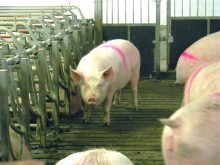”The way to get control of energy use in ahouse is to build it tight and control ventilation.”
Even though oil prices have dropped recently, future home heating costs remain uncertain. As a result, those thinking of building a new house this year may want to consider using energy-efficient construction standards like those in the R-2000 program.
“The way to get control of energy use in a house is to build it tight and control ventilation,” says Gary Sharp, the R-2000 program co-ordinator. And R-2000 homes have to meet very high standards in those two areas.
Read Also

Mazergroup’s Bob Mazer dies
Mazergroup’s Bob Mazer, who helped grow his family’s company into a string of farm equipment dealerships and the main dealer for New Holland machinery in Saskatchewan and Manitoba, died July 6 from cancer.
It must not have an air exchange rate of more than 1.5 times (the house volume) per hour to qualify, which means drafts are virtually eliminated. To put that into perspective, “An old farm house on the prairie may be 10 or 12 times,” says Sharp.
An R-2000 house must meet an energy-use target based on its size. And once certified, a home may qualify for grants or rebates, depending on the province it’s in.
Along with reduced energy consumption, there are other benefits. The use of low-emissions building materials inside the home creates better air quality for the occupants, which can be very important to anyone suffering from allergies or asthma.
And once a home is certified it receives a government certificate, something that could translate into a much higher resale value later on.
Sharp estimates that construction costs for an R-2000 home are only three to five per cent higher than for a standard building. And with a 30 per cent annual energy saving, the payback time could be as short as 10 years.
The R-2000 program started with a single-demonstration house built in Saskatoon back in the mid-1970s, which proved there was room for improvement in home-building standards. “It was quite far out on the energy efficiency curve (for its time),” says Sharp.
But since then, the industry has taken notice and overall building practices have improved, resulting in a higher standard for all Canadian homes. Well-constructed new houses now have an average air exchange rate of between 1.5 and 2.5. That is considerably better than what was common a few decades ago.
“The building code has almost caught up to R-2000,” says Sharp.
Although these homes aren’t as far ahead of mainstream building codes as they used to be, all that is set to change. New standards are currently being drafted that will see energy saving improvements in the range of 50 to 60 per cent over current numbers. Those standards should be in place by 2010.
And R-2000 construction is not limited to houses built on site; ready-to-move (RTM) homes, can be built to those specifications, too. There are several RTM builders across the Prairies certified under the program, and finding one is the first step in starting the construction process. To find an R-2000 builder, visit the program’s national website at http://r2000.chba.ca,or link to the appropriate provincial one.
Sharp says many RTMs have been built to meet R-2000 standards. But the program demands a little more effort on the part of the buyer. There is some preplanning to do.
Courtney Mann of Warman Home Centre, an RTM builder in Saskatchewan, says buyers need to ensure the basement and mechanical systems are also built to R-2000 standards.
“We’re only building from the floor up (on an RTM),” she points out. For all R-2000 home construction, getting a detailed plan approved prior to building is a necessity. With an RTM, all contractors on the project will need to comply with it.



















